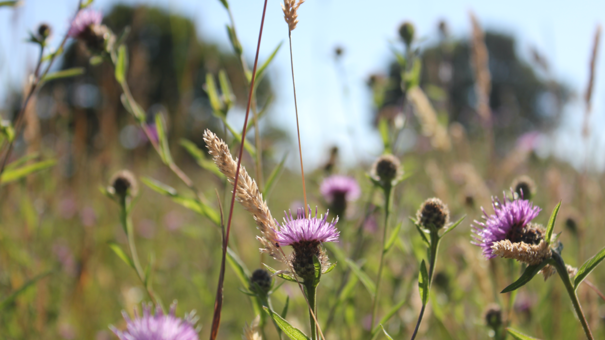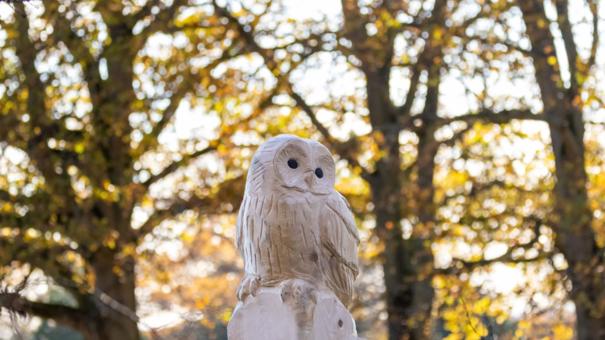As part of a new series on community greenspace management, Trustee Melanie Oxley went to visit Alison Melvin, Chair of Binsted Parish Council, for a walkabout at Blacknest Fields - a site in Hampshire near Alice Holt Forest, which is being managed for nature recovery and as a quiet community greenspace.

On a glorious late summer morning the caramel-coloured grasses were heavy with dew in Blacknest Fields. Meadow brown butterflies flitted about and field crickets made way for us through the sward. The three large fields, totalling 2.7 hectares, lie within the South Downs National Park. Old boundary oaks divide the fields, with a small copse alongside the forest edge.
Historically this land at Blacknest, in Norman times part of the royal hunting forest, was part of a wider wood-pasture landscape, with shifting mosaics of grazing lawns, open-grown trees, thorny scrub and wetland. After the planting of Alice Holt forest in 1812, and the 1850s Inclosures, the 8 acres at Blacknest Fields were awarded to the ‘Overseers of the Poor’ (precursors to parish councils), for ‘the labouring poor’ and ‘to provide exercise and recreation’. One field was used as the parish’s cricket pitch and is a registered Village Green. Over time the site became a forgotten asset, with no public access and used only for horse grazing.
In July 2021 Binsted Parish Council voted to retain the site and they put new governance arrangements in place, recognising the land’s charitable status, and they now manage the site with the help of a fledgling ‘Friends Group’. In April 2022 the first part of the site was opened to the public, as low-key community green space. Community events such as picnics, walks and work parties have since been held. A stunning owl sculpture has been installed near the entrance, given by Binsted’s local village fete organisers. A circular walk has been devised, connecting Butterfly Conservation’s Bentley station meadow to Blacknest Fields’ butterfly meadow.

There is great potential for increasing biodiversity on such a site, i.e. one that has not been cultivated for hundreds of years. Increasing the abundance and diversity of the site’s flora and fauna is high priority within the Management Plan. Being awarded ‘Beelines’ funding by the South Downs National Park has enabled improvements in the meadow and hedge management regimes, to benefit pollinators. The sward has lots of knapweed, and smaller quantities of all-important birds-foot trefoil, vetches, and cats-ear. Plant diversity is already increasing since patches of yellow rattle were established, and by ensuring the resulting hay is cut and collected - although it’s surprisingly hard to find a farmer willing to bale hay on a small site. Ideally cattle would also be introduced, for ‘aftermath grazing’, but this isn’t currently realistic – the fencing isn’t up to it, and the volunteers managing the site are ill-equipped to handle cattle escaping into roads or rose gardens!
For pollinators, hedge and tree flowers are arguably as important as meadow flowers. Funding from Waitrose enabled the planting of a small community orchard. And, as well as planting new hedges, Blacknest’s volunteers have also focused on rejuvenating neglected hedges. A grant from CPRE’s ‘Hedge Fund’ paid for hedge-laying tools and training, while skilful hedge-laying by South Downs volunteers rescued another decrepit hedge. Networking with others has led to plenty of expertise, grant-funding and practical help being offered. Lichenologists, botanists, bird and bat experts, lepidopterists and herpetologists have taken an interest and are conducting all-important baseline surveys.

Owing to its position adjacent to Alice Holt Forest, the site has great wildlife, with birds, bats, reptiles, moths and butterflies utilising the open fields for foraging, lekking (attracting mates) or egg-laying. Marsh tits and spotted flycatchers have been recorded, along with rare moths, bats (including barbastelle), snakes, lizards and toads, and purple hairstreak butterflies.
The Blacknest team is also seeking to make habitat improvements likely to attract species not already-present. It’s hoped that adding hybrid elms will enable the return of the white hairstreak butterfly. Adding a wildlife pond is another ambition that would expand the site’s range of flora and fauna.
However, for Alison, the most important thing is to build up a community of people who enjoy the site - whether as visitors, nature recorders or work-party volunteers:
“It’s really true that ‘people only conserve what they love’. After many decades with no public use of the Blacknest site, we’re building from scratch both the user community and the volunteer community. Collaboration with local wildlife groups is very important, and they’re always extremely generous in sharing their knowledge. But we also need to find ways to involve people who aren’t knowledgeable about wildlife, so they can discover for themselves why we love it so much.
Although our core group is tiny, we can accomplish a lot when volunteers come together to tackle the wildlife projects … so do come along if you’d like to join Blacknest Fields’ Autumn Work Party, on Sunday 29 October, 10:00 – 13:00. As well as tree planting, cutting back bridleway vegetation, and making log-piles for wildlife, we’ll be getting to know each other and enjoying some home-made soup.
Please email [email protected] for joining instructions.”
Melanie’s next visit is to Buriton Parish Council and their work on the Recreation ground.
